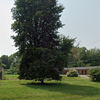Despite concerns, Guilderland Planning Board is likely to advance proposed Foundry Square project to town board
GUILDERLAND — The Guilderland Planning Board appears poised to sign off on the sketch plan for a project that its engineer admitted doesn’t work and whose developer doesn’t want to build.
The move would be legislative, allowing the proposed Foundry Square development to move on to the town board, which has been tasked with deciding whether to allow a project whose density and height are not permitted by town code.
The Markstone Group is seeking approval from the town board, the lead agency for all proposed planned unit developments, known as PUDs, to build two four-story buildings consisting of 285 apartments: 171 two-bedroom units and 114 one-bedroom units.
The development’s proposed four-story height and density of 22 units per acre are not allowed by Guilderland’s zoning code but, in seeking a PUD, Markstone is able to ask the town board to approve the height and density requests because PUDs do not have a set limits on height or density. However, the town board typically uses as guidance the allowable density in its multi-residential district, which is 12 dwelling units per buildable acre.
Town Planner Kenneth Kovalchik likened sketch-plan approval to a subdivision’s concept review stage
“Conceptually, do you think a design like this would work?” Kovalchik said to planning board members at their Sept. 11 meeting. He asked them if it would “work based on the density that’s being proposed?”
Kovalchik explained, “The goal tonight is to get something to the town board for them to make a determination on density. So all these comments kind of should be narrowed down to: Can it work based on the revisions that will be made for the entrances, for the access around the buildings, for parking?”
The board had three major issues with the proposal: the entrance to the site, the ability to maneuver around the buildings, and parking.
“I’m just looking at that entrance and going, ‘I don't think this works’ — you know?” Chairman Stephen Feeney said to project engineer Daniel Hershberg on Sept. 11. “And then can you show us how the fire trucks can get in and out? I think you probably should have circulation around the building.”
The proposal
Hershberg told the board the first proposal submitted to the town had violated setback requirements.
The current iteration, per Kovalchik’s project memo to the board, includes:
— The mix of one- and two-bedroom units across two four-story buildings;
— A minimum of 29 units — 10 percent of apartments — set aside for workforce housing, targeting individuals earning between 80 and 120 percent of the Guilderland area median income, which is about $102,000 per year. Monthly rent plus utilities at 90 percent would be $2,293, while at 120 percent, the area median income would be $3,058.
Kovalchick’s memo recommends the town require 20 percent of the housing be workforce, which Hershberg said Markstone had agreed to;
— Retail or commercial space, totaling 5,000 square feet;
— Indoor amenities including a fitness center, gaming room, business lounge, and community room, totaling 5,000 square feet;
— Outdoor amenities, including pickleball courts, a patio, and a playground.
— The demolition of all existing buildings on the property and the remediation of the parcels’ brownfield site.
Contamination
The proposed project site is the once-home of dry-cleaner Master Cleaners, which was in business from 1956 through 1996. Albany County took title to the property in 2001, following a tax foreclosure. It was then purchased in September 2011 by current owner, Charles Bohl Incorporated.
The site was added to the list of state-designated brownfields in 2016; three years later, the state Department of Environmental Conservation concluded the site posed a significant threat to the public health and environment, and that cleanup of the soil and groundwater was required.
Kovalchik’s memo to the board stated, “Chlorinated solvents are present in soil and groundwater at depths up to 15 feet below grade. Groundwater is present at shallow depths ranging from 1 to 6 feet below grade depending on the season and location.
“There is a distinct confining clay layer at the site ranging from 11 feet to 15 feet below grade that appears to be limiting the vertical migration of contaminants … The contamination has already impacted a tributary of the Hunger Kill and is in close proximity to the Hunger Kill and residential properties along Foundry Road.”
Previous testing of the site found its “primary contaminants of concern” to be “chlorinated volatile organic compounds (VOCs), particularly tetrachloroethene (PCE), trichloroethene (TCE), and their breakdown products. PCE and TCE, widely used in fabric dry-cleaning, are non-flammable, colorless liquids at room temperature that evaporate easily into the air and emit an ether-like odor.”
Chlorinated solvents, like PCE and TCE, “are considered hazardous chemicals that are historically known as recalcitrant compounds that are exceedingly difficult to remediate unless the conditions are ideal for remediation,” according to the federal Environmental Protection Agency.
The solvents are known as “dense non-aqueous phase liquids” (DNAPLs), which are heavier than water, meaning they sink instead of float, which can make for a more difficult clean-up.
Jeff Marx, an environmental engineer from C.T. Male, told board members on Sept. 11 the preferred remediation method is going to be removal of the contaminated earth.
Marx said, “DEC is likely going to want to see removal more so than injection,” and that “injection is going to be more of a remedial option when there’s logistic[al] [issues].”
Problems and proposed solutions
Lack of parking spaces was one issue highlighted by the board.
The apartment complex would need 443 parking spaces to comply with code, but Markstone is providing only 350, according to Kovalchik’s memo. “If additional parking cannot be provided,” he wrote, “it appears that approximately 62 units would have to be removed in order to comply with the parking requirements.”
The solution would be to provide parking underground, but Hershberg said, with a 20-percent workforce housing requirement, the underground parking would make the project economically unfeasible.
Though out of the planning board’s purview, the financing of the project was another issue brought up, as Feeney asked Hershberg if Markstone was already banking on financial assistance from the town’s industrial development agency.
“The applicant’s assuming they’ll get some tax abatement level from the IDA eventually,” Hershberg said, but “whether or not that’s enough” to help the project over the financial hump — “you know, we’re trying to work a project with so many problems on it; we’re trying to get something that works, which requires the cooperation of the town, New York State DOT engineers, applicants, consultants to get it to work.”
The state Department of Transportation, for its part, made recommendations, including:
— The installation of a sidewalk on the southeastern side of Route 20 from the proposed project site to the CDTA stop at the Guilderland Public Library;
— The installation of sidewalks to the traffic signal at the corner of Foundry Road and Route 20;
— The installation of pedestrian signals at the corner of Foundry Road and Route 20.
— Working with CDTA to install a bicycle rack and bus shelter at its stop at the library; and
— Consideration of pushing the building farther away from Route 20 to improve site lines and allow for any future changes to the road network.
The DOT in its memo to the town also noted that segment of Route 20 already had problems with “wet road and rear end collisions” and advised “additional consideration should be made concerning traffic mitigation on to Western Avenue.”
Next steps
The planning board went out of its way to acknowledge it didn’t want to stop the project cold in its tracks with a negative report.
“So to move forward, I mean, we have our concerns.,” Chairman Feeney said to Hershberg. He noted that board member Dominic Rigosu said “the site really doesn’t work as laid out, but for your client to give you the green light, to start spending money to examine some of these things, you’re saying they want to hear from the town board on the density and the four stories.”
Feeney went on, “So if that’s it and we still have all these site plan issues, we can still have all these site plans issues.”
Feeney then turned to Kovalchik and said, “Do we point these [issues] out to the town board and say, ‘Hey, but if they can make it work, the planning board [is OK] with four stories.’ I mean, I just don't know how — I mean, I don’t want to be the hold-up here.
Kovalchik responded to Feeney, “Ultimately, it’s a legislative decision.” The town board is Guilderland’s legislative body.
The goal of the Sept. 11 meeting was to see if the planning board was supportive of the density and height being proposed by Markstone, after which a more detailed and in-depth engineering analysis will take place.
It was agreed that Kovalchik would write a report for the board to vote on at its Sept. 25 meeting.



